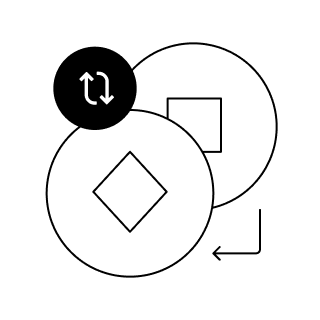What’s Qtum (QTUM)? How can I buy it?
What is Qtum?
Qtum (pronounced “Quantum”) is a public, open-source blockchain platform that aims to combine the proven security of Bitcoin’s UTXO model with the flexibility of Ethereum-style smart contracts. Launched in 2017 by the Qtum Foundation, the network was designed to serve as an enterprise-friendly and developer-accessible platform for decentralized applications (dApps), decentralized finance (DeFi), and token issuance.
Qtum’s native token, QTUM, is used for transaction fees, staking, and governance signaling. From its inception, Qtum prioritized compatibility and stability, enabling developers to port Ethereum smart contracts while benefiting from Bitcoin’s robust transaction model. The project’s architecture centers around the Account Abstraction Layer (AAL), which bridges the UTXO model with an account-based virtual machine, and a Proof-of-Stake (PoS) consensus mechanism to secure and scale the network efficiently.
Notable design goals include:
- Security via Bitcoin’s UTXO model
- Flexibility through EVM compatibility and an abstraction layer
- Energy efficiency using Proof-of-Stake
- On-chain governance and upgradability with a decentralized governance protocol
How does Qtum work? The tech that powers it
Qtum’s architecture is a layered design that blends established blockchain components with custom middleware to enable smart contracts on a UTXO-based chain.
-
Bitcoin UTXO Foundation
- Transaction Model: Qtum uses an Unspent Transaction Output (UTXO) ledger similar to Bitcoin. UTXOs provide a simple, verifiable transaction structure with strong parallelization properties and well-understood security assumptions.
- Benefits: Deterministic verification, battle-tested code paths, and improved scalability for certain wallet and node operations.
-
Account Abstraction Layer (AAL)
- Purpose: The AAL maps the UTXO model to an account-based paradigm so that smart contracts, which typically expect accounts and balances (like on Ethereum), can operate on a UTXO chain.
- How it works: The AAL interprets special transaction types that invoke contract calls, maintain contract state, and serialize/deserialize data so that higher-level virtual machines can function transparently.
- Outcome: Developers can write and deploy contracts as if they were on an account-based chain, while the base layer retains UTXO’s security model.
-
EVM Compatibility
- Qtum integrates an Ethereum Virtual Machine (EVM) environment, allowing Solidity smart contracts and many Ethereum tooling stacks to run with minimal changes.
- Developer Tooling: Common tools like Solidity compilers, ABI interfaces, and many Ethereum libraries can work on Qtum, easing migration and multi-chain strategies.
-
Proof-of-Stake Consensus
- Mechanism: Qtum uses a PoS consensus that lets token holders stake QTUM to participate in block production and earn rewards.
- Energy Efficiency: PoS dramatically reduces energy consumption compared to Proof-of-Work.
- Security and Finality: Staking aligns incentives for honest participation; block intervals and difficulty adjustment are configured to balance throughput and security.
-
Decentralized Governance Protocol (DGP)
- Upgradability: DGP lets stakeholders adjust certain network parameters on-chain (e.g., block size, gas schedule) without contentious hard forks.
- Governance Flow: Parameter changes are proposed and voted on via smart contracts, which enact updates if predefined criteria are met, enabling flexible and responsive protocol evolution.
-
Oracles and Interoperability
- Oracles: Qtum supports oracle mechanisms that feed external data to smart contracts, a key capability for DeFi and real-world use cases.
- Cross-Chain: While not natively a cross-chain protocol, Qtum’s EVM compatibility and standard token interfaces facilitate bridges and multi-chain integrations, depending on third-party solutions.
-
Wallets and Infrastructure
- Light Clients and Full Nodes: The network supports standard node setups, with staking typically done via full nodes or delegated setups.
- Tooling and SDKs: Documentation and libraries support contract deployment, wallet management, and dApp development across multiple languages and frameworks.
What makes Qtum unique?
- Hybrid Architecture: Qtum’s fusion of Bitcoin’s UTXO model with EVM smart contracts through the AAL remains relatively rare. This hybridization offers Bitcoin-like security assurances with Ethereum-like programmability.
- On-Chain Parameter Governance: The DGP enables adaptive upgrades without hard forks for many parameters, lowering governance friction and reducing the risk of fragmentation.
- Enterprise Orientation: Early design goals emphasized stability, compatibility, and predictable upgrades—valuable for enterprise and institutional adopters who require long-term support and minimized protocol risk.
- Energy-Efficient Staking: Qtum’s PoS consensus makes it more accessible for participants to secure the network without specialized hardware.
Qtum price history and value: A comprehensive overview
Note: Cryptocurrency markets are highly volatile. Always consult multiple reputable sources for current data.
- Launch and Early Trading (2017–2018)
- Qtum launched during the 2017 bull market. Like many assets of that era, it saw rapid appreciation followed by a sharp correction in 2018.
- Cyclical Market Behavior (2019–2021)
- Price action generally tracked broader crypto cycles. Interest resurfaced during the 2020–2021 bull market as DeFi and multi-chain narratives expanded.
- Recent Phases
- Post-2021, QTUM, like many altcoins, experienced drawdowns amid tighter macro conditions and crypto-specific risk events. Periods of recovery have typically coincided with broader market uptrends, developer milestones, or ecosystem integrations.
Key value drivers to watch:
- Network Utilization: Growth in active addresses, deployed contracts, and on-chain transactions.
- Developer Momentum: Tooling improvements, EVM upgrades, and integrations with wallets and bridges.
- Governance and Upgrades: Parameter changes via DGP that improve throughput or reduce costs.
- Macro and Liquidity Conditions: Bitcoin cycles, risk appetite, and regulatory environment.
Is now a good time to invest in Qtum?
This is not financial advice. Whether Qtum is a good investment depends on your risk tolerance, time horizon, and conviction in its technology and ecosystem.
Consider the following:
- Thesis Fit: Qtum targets a niche where Bitcoin’s transaction model and Ethereum’s smart contracts converge. If you believe hybrid architectures with on-chain governance and EVM compatibility will gain adoption, Qtum can be a targeted play.
- Competitive Landscape: Qtum competes with EVM chains, rollups, and alternative L1s. Assess network effects, developer traction, and liquidity compared with larger ecosystems.
- Staking Yield and Participation: Staking can offer rewards that partially offset volatility. Understand lockups, hardware/wallet requirements, and security best practices.
- Technology and Roadmap: Review the latest documentation and GitHub activity for progress on EVM upgrades, performance improvements, and ecosystem partnerships.
- Diversification and Risk: Altcoins carry significant volatility and idiosyncratic risk. A diversified approach and position sizing aligned with your broader portfolio can mitigate downside.
Practical steps before deciding:
- Read Qtum’s official documentation, especially on AAL, DGP, and staking mechanics.
- Compare transaction fees, block times, and finality with other EVM-compatible networks.
- Check reputable data aggregators for on-chain metrics and liquidity depth.
- Review independent security research and recent audits of core components and major dApps.
By grounding your decision in the network’s technical architecture, governance model, and real usage metrics, you can better evaluate Qtum’s long-term potential relative to peers.
Discover the different ways to buy crypto in the UAE
Create an OKX account
Get verified
Start a trade
Enter an amount
Choose your payment method
Confirm your order
All done
Create an OKX account
Get verified
Start a trade
If Qtum isn’t available in the dropdown, purchase any of the available tokens and convert it to QTUM.
Place a buy order
Complete your purchase
Receive your QTUM
All done
Get the OKX app or Wallet extension
Set up your wallet
Fund your wallet
Find your next purchase
Note:
Tokens with the same symbol can exist on multiple networks or may be forged. Always double-check the contract address and blockchain to avoid interacting with the wrong tokens.
Trade your crypto on OKX DEX
Choose the token you’re paying with (e.g., USDT, ETH, or BNB), enter your desired trading amount, and adjust slippage if needed. Then, confirm and authorize the transaction in your OKX Wallet.
Limit order (optional):
If you’d prefer to set a specific price for your crypto, you can place a limit order in Swap mode.
Enter the limit price and trading amount, then place your order.
Receive your crypto
All done

Make informed decisions


How to get Qtum for free
See what you can do with your crypto
How to buy Qtum (QTUM) FAQ
Disclaimer
You are viewing content that has been summarized by AI. Please be aware that the information provided may not be accurate, complete, or up-to-date. This information is not (i) investment advice or an investment recommendation, (ii) an offer, solicitation, or inducement to buy, sell or hold digital assets, or (iii) financial, accounting, legal or tax advice. Digital assets are subject to market volatility, involve a high degree of risk, and can lose value. You should carefully consider whether trading or holding digital assets is suitable for you in light of your financial condition and risk tolerance. Please consult your legal/tax/investment professional for questions about your specific circumstances.














